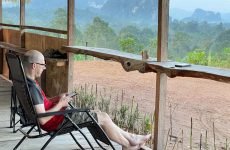Astana Negeri Sarawak is one from among the few iconic buildings from the Rajah Brooke’s ruling in Sarawak, the land of Borneo. It is located in Kuching, Sarawak, East Malaysia. This “Seat of Government” building still faithfully serving even until today as it currently becomes the official residence of the Governor of Sarawak.
You will never get to miss this building whenever you visit Kuching Waterfront. It stands prominently on the northern banks of Sarawak River, you will get to see from across Kuching Waterfront with big letter words ASTANA written in front of it. This name is actually a variation of ‘istana‘ meaning palace. The word ‘istana’ is reserved only for Sultans, thus the word ‘astana’ is being used instead.
History of Astana Negeri Sarawak
It was the exact spot of James Brooke first house – Mr Brooke’s Residence
Long before Astana being erected, the spot housed James Brooke’s first house in Sarawak, simply called “Mr Brooke’s Residence”. He was an English adventurer who was given governorship of Sarawak (at that time only covering from Tanjung Datu to Semarahan River basin) for his assistance in quelling a rebellion against the Sultanate of Brunei in the 1840s. He was installed as the First Rajah on 18 August 1842. The first house was built by local Malays using local materials and following local Malay design.
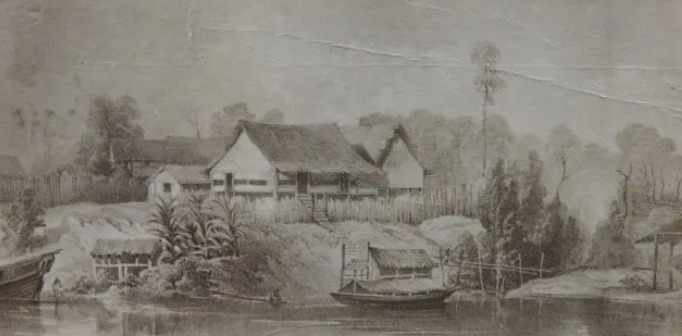
James Brooke second house was located on the edge of the current Kampung Sungei Bedil – The Grove
This house however, as James Brooke has recognized, was not constructed with a view of permanence therefore between the end of 1842 and early 1843, he built a second more substantial house on the opposite bank of Sungei Bedil , on the edge of where Kampung Sungei Bedil is now located. The second house is called “The Grove” and it reflected something of Anglo-Indian bungalow with a mix of Malay design. “The Grove” was burned down on the morning of 19 February 1857 when Hakka goldminers from Bau attacked Kuching and forced the Rajah to flee to the coast.
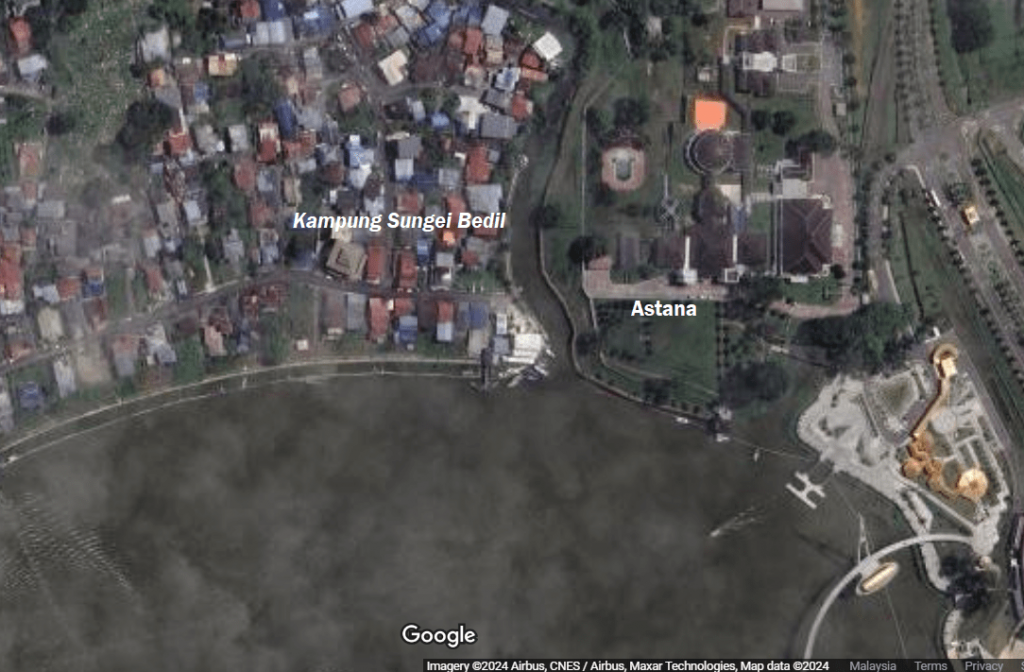
James Brooke third house was located back to Astana present spot – Government House
After that, James Brooke rebuilt his third house back to Astana present spot. It was named “Government House”. This house incorporate Malay design features similar to that of elite domestic architecture from British Malaya and Singapore. He barely lived in it as he retired not long afterwards to England. He returned to Sarawak in 1861 to install Brooke Brooke, as Rajah Mudah and again in 1863 to disinherit him and banishing him for rebellion and declaring him as outlaw. While Brooke Brooke stayed in the Government House during a short 3 and half years there, he lost two wives and a son. James Brooke died on 11 June 1867 aged 65 with Brooke following him to the grave 18 months later.
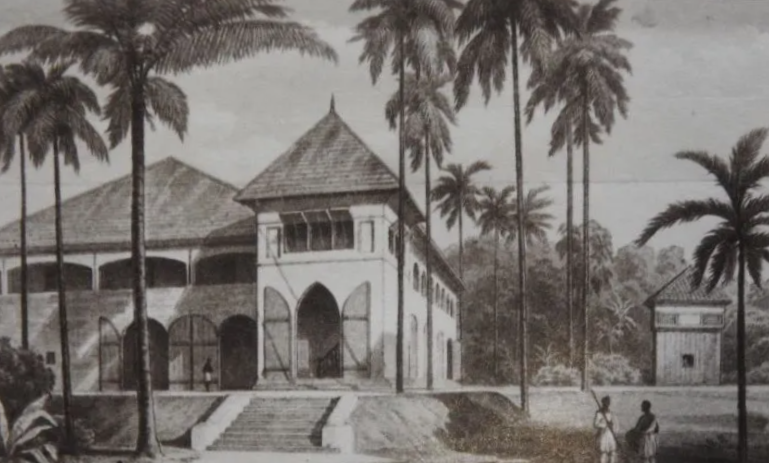
Charles Brooke rebuilt Government House to the Astana for his wife
Charles Brooke became the Second Rajah after James Brooke passed away. After he stabilized his rule, he left for England in 1869 to marry an European wife. Although he was married before to a local woman named Dayang Mastiah, he was looking for more secure political position, thus he married Margaret Alice Lili de Windt on 28 September 1869. Before leaving, he ordered for partial dismantling and substantial rebuilding of Government House into a new and even grander residence. It was to be prepared as wedding gift to for his bride Margaret, who became known as Ranee Margaret and as a formal residence to reflect the Rajah’s growing political stature. In 1870, a year later, The Astana Negeri Sarawak was built. Initially, it was still called Government House but few years later, the name transitioned to the “Astana” to reflect its role as a royal residence.
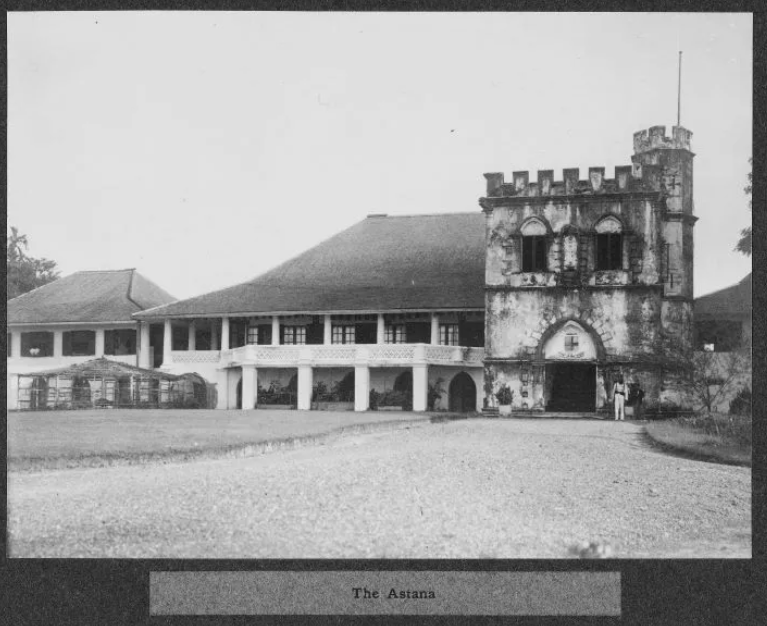
How Astana looked like?
The Astana is far grander than any of First Rajah’s houses. It was built in bricks and mortar, with high-pitched roof, belian shingles and wide eaves demonstrating its influence of Malay architecture designs, along with deep veranda and internal layout pointing to European influences.
The original palace design was quite unusual because three separate building connected together as one with one building connected to the other by short and narrow passageways. Originally, there was only one tower, which is located on the right side. It was a crenelated tower; constructed in the style of ancient fortress and features battlement at the top and narrow windows throughout the building. These windows were strategically placed to allow the people inside to fire their guns at any invaders. The Rajah’s family coat of arms – Dum Spiro Spero in Jawi script and the year of establishment was displayed above the main gate of that tower.
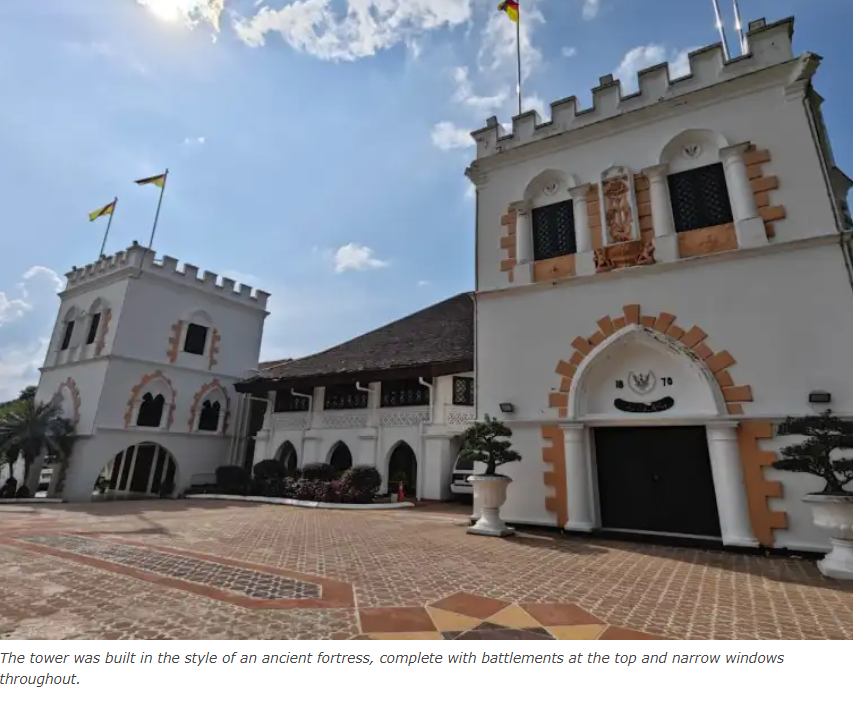
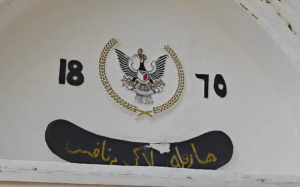
There was a small areca nut trees plantation (also known as betel nuts) behind the Astana. The Rajah used to cultivate them for the benefit of his Dayak friends whenever they visited him. They even contacted him for supplies of these nuts when they planned to host large feasts. He would provide them in inexpensive jars for them to transport back to their homes.
Interesting happenings at the Astana
In 1870
According to Chater in ‘Sarawak Long Ago’, although the structure was completed when Rajah Charles and Ranee Margaret arrived in 1870, there was little furniture. They have to stay with Bertha and Arthur Crookshank in their bungalow near Fort Margherita. This has caused the Ranee so much embarrassment. The Ranee was just half the age of his husband. As soon as the Astana was constructed, Chinese merchants started sending gifts. Law Kian Huat and his business partner, Sim Ah Nio of Ghee Soon & Company gave a very generous gift of 12 pairs of Chinese lamps. Almost as soon as the Ranee entered the Astana, she started to bear her large family. In total, she gave birth to 7 children. One was a stillborn son and the other 3 of the older siblings died at a very young age.
During Second Rajah’s ruling
Charles Brooke during his ruling ran his country like an English country estate. He would stand on the Astana verandah with a telescope to observe the arrivals of his officers at their respective offices, which was located right opposite of Sarawak River, where the Old Courthouse is standing now. Any latecomers will receive notice of reminder within only minutes later. He also had one fixed rule: everyone in the Astana awoke at the sound of 5am gunshot in the morning and dined at 8pm gunshot in the evening.
During Third Rajah’s ruling
The third and last Rajah was Charles Vyner Brooke. He continue to occupy the Astana following his father’s tenure. Many changes happened during his ruling. The most significant ones were WW2 and the Japanese Occupation (1941-1945). After the war, he ceded Sarawak to the British Crown in 1946.
Creepers – Bad Luck?
‘Kuching in Pictures 1841-1946’ and ‘Sarawak Long Ago’ books mentioned about a local creepers covering the tower of the Astana. Removal of these creepers would bring bad luck. During the war, Prince (Toshinari) Maeda of Japan occupied the Astana and cut down the creepers. Three days later, he was killed when the plane he was in crashed into the sea of Bintulu. Rumors also mentioned that he was killed by his own pilot due to resentment of being humiliated as the Prince slapped the pilot just the night before when he was heavily drunk.
The Astana Current Role
Over time, the Astana continued to serve as official residence of Colonial Governors, and after gaining independence, by Sarawak-born Governors. They are not open to visitors except for certain days, therefore it would be sufficient to view the Astana from across the Sarawak river at the Kuching Esplanade.
Sources:-
-
- Kuching in Pictures 1841-1946 by Ho Ah Chon
- Sarawak Long Ago by W J Chater
Do you know?
Looking for travel information about Kuching, Malaysia may give you insufficient information and it can be overwhelming. We discover that there is a metasearch website specifically for travel. Introducing you KAYAK which would do good job in reducing half of your planning and decision making. They allow you to search for flights, stays, car rentals and packages with the best deals.
You may still want to have your questions answered while planning your trip to Kuching, Malaysia. Get away from the hassle of not getting sufficient information by getting your live, real human travel consultant virtually. With minimum charges of MYR10 per hour, you can get all required information needed for travel planning. You can call, chat or video call us throughout your stay in the city, until you reach your next destination. Click here for virtual travel consultant service.


